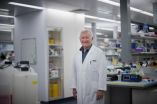(Press-News.org) From identifying common patterns in data to speeding up computers, researchers from the Department of Energy's Pacific Northwest National Laboratory will share their computational expertise at this year's Supercomputing conference.
Also referred to as SC 12, the annual gathering is the international conference for high-performance computing, networking, storage and analysis. It runs Nov. 10-16 at the Salt Palace Convention Center in Salt Lake City. Two noteworthy talks featuring PNNL research are described below.
New algorithm pin-points similar data in seconds
Data is everywhere these days. Biologists sift through vast amounts of error-prone data to understand how our cells work. Even librarians slog through mountains of information to better understand the materials they catalog. The key to comprehending today's information explosion is finding meaningful patterns buried in the data – and then finding comparable data patterns in other, related sources. This technique is called network alignment. Computational scientists at PNNL and Purdue University have developed new methods to identify similar patterns in any type of data. Their procedures help find proteins that act the same in humans and mice, and help find ideas that act the same for librarians and Wikipedia editors.
The existing methods used to solve these kinds of problems have been too slow to cope with the growing amount of data, prompting the PNNL and Purdue team to make them faster. To do this, they developed a new algorithm that uses an approach called approximate matching, which saves time by matching nearly identical patterns instead of exactly identical ones. They also developed new computer implementations that enabled the algorithm to use all a computer's processors in parallel to quickly identify relationships between two different networks. Tests using both of these improvements showed that the algorithm found similar interactions between thousands of proteins in two species in just seconds and found comparable ideas between hundreds of thousands of topics in library systems and Wikipedia entries in less than a minute.
PNNL's Mahantesh Halappanavar led the research on how to quickly find approximate matchings with help from Purdue's Arif Khan and Alex Pothen. And, Purdue's David Gleich led the work on how to use approximate matchings to align networks. Gleich will present a paper describing this research Wednesday.
4:30- 5 p.m., Wed., Nov. 14: A multithreaded algorithm for network alignment via approximate matching, Arif Khan, David Gleich, Mahantesh Halappanavar & Alex Pothen, Room 355-EF, http://sc12.supercomputing.org/schedule/event_detail.php?evid=pap468.
Software translates code, speeds up data-crunching
Large and complex networks in parallel computers can lead to inefficient communications between processors that also slows down computation. This makes it difficult to achieve exascale computing, which is one thousand times faster than today's fastest petascale supercomputers. Scientists are developing strategies to reduce the time it takes to compute data and communicate those results between parallel processors. A team of researchers from PNNL, University of California, San Diego, and Lawrence Livermore National Laboratory have developed new software called Bamboo to help do just that.
Traditionally, scientists have broken up a complex algorithm to speed things up. Different processors calculate bits of the algorithm and then each processor communicates its results to the others. Such division of labor is quicker than one processor doing all the work by itself. But communicating bunches of data between multiple processors can cause information bottlenecks that slow down the whole process. One solution is to initially calculate a portion of a processor's data and communicate those results while the other portion is still being calculated. Called overlapping communications and calculations, this approach can reduce the overall time it takes to complete a job, but it requires extremely complex codes. That's where Bamboo comes in. Bamboo automatically translates standard MPI parallel codes into a format that can easily overlap communication with available computation. Without Bamboo, scientists have the onerous task of manually developing overlapping MPI code. Tests showed Bamboo-generated code was as good as or better than human-developed codes.
PNNL's Eric Bylaska drew on his experience developing complex code for NWChem, DOE's premier molecular modeling software package, to help develop realistic test programs for the Bamboo framework. The University of California, San Diego's Scott Baden, who led the project, will present a paper describing the team's results Wednesday.
10:30-11 a.m., Wed., Nov. 14: Bamboo – Translating MPI Applications to a Latency-Tolerant, Data-Driven Form, Tang Nguyen, Pietro Cicotti, Eric Bylaska, Dan Quinlan & Scott Baden, Room 255-EF, http://sc12.supercomputing.org/schedule/event_detail.php?evid=pap142
###
Interdisciplinary teams at Pacific Northwest National Laboratory address many of America's most pressing issues in energy, the environment and national security through advances in basic and applied science. PNNL employs 4,500 staff, has an annual budget of nearly $1 billion, and has been managed for the U.S. Department of Energy by Ohio-based Battelle since the laboratory's inception in 1965. For more, visit the PNNL's News Center, or follow PNNL on Facebook, LinkedIn and Twitter.
PNNL expertise highlighted at Supercomputing
Algorithm that identifies matching patterns, MPI code translator to be discussed Nov. 14
2012-11-14
ELSE PRESS RELEASES FROM THIS DATE:
Computer science helping the aged stay home
2012-11-14
University of Adelaide computer scientists are leading a project to develop novel sensor systems to help older people keep living independently and safely in their own homes.
The researchers are adapting radio-frequency identification (RFID) and sensor technologies to automatically identify and monitor human activity; to be able to determine if an individual's normal routine is being maintained so that timely assistance can be provided if it is needed.
Although RFID technology has been around since World War 2 and is in common use today in applications such as anti-shoplifting ...
Preserve the services of mangroves -- Earth's invaluable coastal forests, experts urge
2012-11-14
Experts are urging policy makers to preserve mangroves and their essential services to nature and humanity alike, saying their replacement with shrimp farms and other forms of development is a bad economic tradeoff both short and long-term.
An unprecedented partnership of organizations – from forestry and conservation sectors and from across the United Nations – have released a policy brief drawing on the 2nd edition of the World Atlas of Mangroves (2010). It aims to provide managers with lessons learned in past mangrove conservation and management efforts, and with policy ...
The leggiest animal on Earth lives in the outskirts of Silicon Valley
2012-11-14
The leggiest animal in the world, the millipede lllacme plenipes, was re-discovered several years ago in California by Paul Marek. Now, Marek and his colleagues provide further details of the surprisingly complex anatomy of this diminutive creature and its extreme rarity, limited to a handful of spots just south of San Francisco. More details about the species and its biology can be read in an article that was recently published in the open access journal ZooKeys.
Millipedes have the most legs of any animal group. From their ancestors with just one pair of legs per body ...
Lost in space: Rogue planet spotted?
2012-11-14
Astronomers using ESO's Very Large Telescope and the Canada-France-Hawaii Telescope have identified a body that is very probably a planet wandering through space without a parent star. This is the most exciting free-floating planet candidate so far and the closest such object to the Solar System at a distance of about 100 light-years. Its comparative proximity, and the absence of a bright star very close to it, has allowed the team to study its atmosphere in great detail. This object also gives astronomers a preview of the exoplanets that future instruments aim to image ...
Astronomers find 'homeless' planet wandering through space
2012-11-14
A planet that is not orbiting a star, effectively making it homeless, has been discovered by a team of University of Montreal (UdeM) researchers working with European colleagues and data provided by the Canada-France-Hawaii Telescope (CFHT) and the European Southern Observatory's Very Large Telescope (VLT). "Although theorists had established the existence of this type of very cold and young planet, one had never been observed until today," said Étienne Artigau, an astrophysicist at UdeM. The absence of a shining star in the vicinity of this planet enabled the team to study ...
Georgia Tech releases cyber threats forecast for 2013
2012-11-14
The year ahead will feature new and increasingly sophisticated means to capture and exploit user data, escalating battles over the control of online information and continuous threats to the U.S. supply chain from global sources. Those were the findings made by the Georgia Tech Information Security Center (GTISC) and the Georgia Tech Research Institute (GTRI) in today's release of the Georgia Tech Emerging Cyber Threats Report for 2013. The report was released at the annual Georgia Tech Cyber Security Summit, a gathering of industry and academic leaders who have distinguished ...
Pancreas stem cell discovery may lead to new diabetes treatments
2012-11-14
Stem cells in the adult pancreas have been identified that can be turned into insulin producing cells, a finding that means people with type 1 diabetes might one day be able to regenerate their own insulin-producing cells.
The discovery was made by scientists from the Walter and Eliza Hall Institute and provides further evidence that stem cells don't only occur in the embryo.
The ability to produce the hormone insulin is crucial for controlling blood sugar (glucose) levels. In people with type 1 diabetes the body's immune system destroys the insulin-producing beta cells ...
Antibody-coated stents: Indication of disadvantages
2012-11-14
If narrowed or blocked coronary vessels have to be widened or opened, a vascular support (stent) is usually inserted. Drug-coated stents are preferred for patients at high risk of renewed narrowing of vessels (restenosis). However, the use of antibody-coated stents has been increasing in recent years. Current studies provide indications that these new antibody-coated stents more frequently lead to myocardial infarction and make re-operation necessary. This is the conclusion reached in the rapid report of the German Institute for Quality and Efficiency in Health Care (IQWiG), ...
'Missing link' discovered in the defence mechanism of the tuberculosis pathogen
2012-11-14
Brussels, 14 November 2012 – Flemish biologists lead by Joris Messens (VIB / Vrije Universiteit Brussel) have discovered that Mycobacterium tuberculosis – the bacterium that causes tuberculosis – has an ingenious defence mechanism against oxygen. This knowledge is important in the search for a treatment for tuberculosis. 9.4 million people are infected with tuberculosis annually and 1.7 million people die as a result.
Joris Messens: "We have discovered how Mycobacterium survives the oxygen stress in our body, namely with the aid of the protein mycoredoxin-1. This opens ...
Triclosan in cosmetics and personal care products can increase allergy risk
2012-11-14
Triclosan - an antibacterial chemical found in toothpaste and other products - can contribute to an increased risk of allergy development in children. This comes from the Norwegian Environment and Childhood Asthma Study, in which the Norwegian Institute of Public Health is involved. Similar results are reported in the USA.
Triclosan has been in use for decades, but was recently associated with allergies in children in an American study, the National Health and Nutrition Examination Survey (NHANES). The new Norwegian study found similar associations between allergies ...
LAST 30 PRESS RELEASES:
Making lighter work of calculating fluid and heat flow
Normalizing blood sugar can halve heart attack risk
Lowering blood sugar cuts heart attack risk in people with prediabetes
Study links genetic variants to risk of blinding eye disease in premature infants
Non-opioid ‘pain sponge’ therapy halts cartilage degeneration and relieves chronic pain
AI can pick up cultural values by mimicking how kids learn
China’s ecological redlines offer fast track to 30 x 30 global conservation goal
Invisible indoor threats: emerging household contaminants and their growing risks to human health
Adding antibody treatment to chemo boosts outcomes for children with rare cancer
Germline pathogenic variants among women without a history of breast cancer
Tanning beds triple melanoma risk, potentially causing broad DNA damage
Unique bond identified as key to viral infection speed
Indoor tanning makes youthful skin much older on a genetic level
Mouse model sheds new light on the causes and potential solutions to human GI problems linked to muscular dystrophy
The Journal of Nuclear Medicine ahead-of-print tip sheet: December 12, 2025
Smarter tools for peering into the microscopic world
Applications open for funding to conduct research in the Kinsey Institute archives
Global measure underestimates the severity of food insecurity
Child survivors of critical illness are missing out on timely follow up care
Risk-based vs annual breast cancer screening / the WISDOM randomized clinical trial
University of Toronto launches Electric Vehicle Innovation Ontario to accelerate advanced EV technologies and build Canada’s innovation advantage
Early relapse predicts poor outcomes in aggressive blood cancer
American College of Lifestyle Medicine applauds two CMS models aligned with lifestyle medicine practice and reimbursement
Clinical trial finds cannabis use not a barrier to quitting nicotine vaping
Supplemental nutrition assistance program policies and food insecurity
Switching immune cells to “night mode” could limit damage after a heart attack, study suggests
URI-based Global RIghts Project report spotlights continued troubling trends in worldwide inhumane treatment
Neutrophils are less aggressive at night, explaining why nighttime heart attacks cause less damage than daytime events
Menopausal hormone therapy may not pose breast cancer risk for women with BRCA mutations
Mobile health tool may improve quality of life for adolescent and young adult breast cancer survivors
[Press-News.org] PNNL expertise highlighted at SupercomputingAlgorithm that identifies matching patterns, MPI code translator to be discussed Nov. 14




